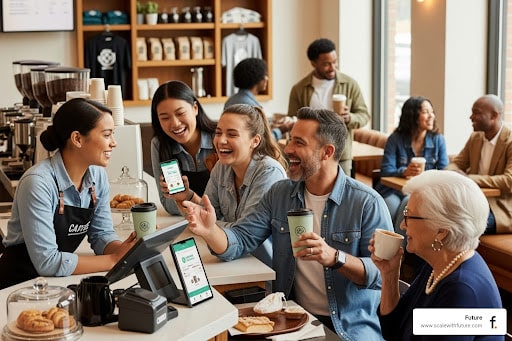
Customer retention strategies are the tactics businesses use to keep existing customers engaged, satisfied, and making repeat purchases. These strategies focus on building long-term relationships rather than just acquiring new customers.
Key Customer Retention Strategies:
Why retention matters so much: It costs 5-25 times more to acquire a new customer than to keep an existing one. A 5% increase in customer retention can boost your profits by 25-95%.
For health and wellness brands, retention is critical. Your customers are on personal journeys, and when you help them succeed over time, they become incredibly loyal advocates.
The average business loses 15-20% of its customers annually. But companies that master retention turn customers into their most powerful growth engine.

Customer retention is the ability to turn initial buyers into loyal, repeat customers, preventing them from switching to a competitor. It’s the art of nurturing relationships for sustained revenue and long-term brand loyalty. Acquiring a new customer is like a first date—exciting but uncertain. Retaining one is like a long-term relationship, requiring consistent effort for more substantial rewards.
The economics are clear. While attracting new customers is essential for growth, keeping existing ones is the most cost-effective path to profitability. As much as 80% of a firm’s future profits will derive from just 20% of its existing customers. Investing in retention is a business imperative, leading to cost savings, a healthier bottom line through repeat purchases and upselling, and turning satisfied customers into brand advocates. For a deeper dive into the financial benefits, you can explore the economics of e-loyalty.
Let’s talk about how data, creativity, and performance strategy can drive real growth.
Partner with Future Digital to turn insights into measurable results.
Building lasting relationships with your customers is essential for thriving in the competitive health and wellness space. When customers feel cared for and supported on their wellness journey, they become customer loyalty champions who boost customer satisfaction, increase their customer lifetime value (CLV), make repeat purchases, and become passionate brand advocacy voices.
Your customers are on deeply personal journeys. Your role goes far beyond selling products—you're their trusted partner in change.
Here are 14 proven customer retention strategies for health and wellness brands:
First impressions are critical; the relationship truly begins with the first purchase. A smooth onboarding process guides customers from excitement to results. They've invested in their health with your brand and want to succeed. Provide clear communication on next steps, product usage, and where to find help. A thoughtful welcome email series can offer tips and set expectations. Research from Gartner on software purchase regret shows complicated onboarding is a leading cause of churn. Setting and meeting expectations from day one builds foundational trust for loyalty.
Great customer service isn't just about solving problems; it's about showing customers they matter. When customers reach out, they're often feeling vulnerable or frustrated. Your response can make or break the relationship.

According to the service recovery paradox, when you handle a mistake well, customers often become more loyal than if the problem never happened. People remember how you made them feel when things went wrong.
Omnichannel support means meeting customers where they are (chat, email, phone). Quick response times are vital. Train your team in empathy and equip them with a unified customer view through a good CRM to ensure every interaction feels personal. A study by Bain & Company on customer loyalty confirms that exceptional service creates emotional bonds that keep customers coming back.
Don't assume you know what customers want—ask them. Your customers use your products daily and have insights you can't get from internal meetings alone.
Build a feedback loop with multiple touchpoints. Surveys and Net Promoter Score® (NPS) provide quantifiable data, while customer reviews and social listening reveal the stories behind the numbers.
The crucial part is acting on feedback. When customers see their suggestions lead to improvements, they feel heard and valued. Use root cause analysis to dig deeper than surface complaints. For more on measuring satisfaction, explore the principles of Net Promoter Score®.
In a world of generic messages, personalization stands out. It's no longer a nice-to-have; 71 percent of consumers expect personalization, and 76% get frustrated when it's missing.

Use customer data for smart segmentation to send the right message at the right time. Personalized recommendations based on past behavior show you understand their needs.
Quizzes for personalization are powerful in health and wellness. Take Pepper's fit quiz as an example—by understanding each customer's needs, they recommend products that work, creating a better experience and stronger loyalty.
Building a brand community taps into the human need for connection and a sense of belonging. Create spaces—like an online forum or Facebook group—where customers can share experiences, support each other, and feel part of something bigger.
User-generated content flows naturally from engaged communities, providing authentic social proof. Online forums and exclusive access to new products make members feel special. LEGO's IDEAS platform shows how powerful community involvement can be. With 41 percent of consumers joining more online communities, it's a great time to bring your customers together.
A great loyalty program feels like a genuine thank-you. Points systems and tiered rewards create a sense of progression, while VIP benefits and exclusive perks make customers feel special.
Understand what your customers truly value. Some want discounts, others prefer early access or exclusive content. Reward programs work best when they align with your customers' desires. Nerdy Nuts rewards program does this well by offering multiple ways to earn and redeem points, keeping engagement high.
Customers buy into stories and values, not just products. Creating an emotional connection through authentic brand storytelling can turn casual customers into devoted advocates.
Your brand mission should be a genuine reflection of why you exist. Authenticity matters more than polish. Corporate Social Responsibility (CSR) is also good for business. Research shows that 55 percent of consumers buy from brands with a story they love. When your values align with your customers', loyalty becomes natural.
The customer journey doesn't end at checkout. Post-purchase communication and order tracking keep customers informed, while a hassle-free returns policy removes buying friction.
A sobering statistic: 67% of people check a return policy before buying, and 58% won't buy again after a bad returns experience. Making returns easy is smart business.
Unexpected extras like personalized follow-up emails or small surprise gifts can transform a transaction into a memorable experience. Chubbies' return policy is legendary for being customer-friendly, turning potential friction into brand love.
Email remains one of the most effective ways to nurture customer relationships. Email automation lets you send timely messages, while newsletters keep customers engaged between purchases.
Win-back campaigns can re-engage lapsed customers with special offers. Personalized offers based on purchase history show you remember their preferences, and educational content provides value beyond just selling. Mack Weldon's feedback email is a great example of combining a request for input with genuine value.
For regularly used products, a subscription model offers convenience for customers and recurring revenue for your business.
Subscribe-and-save discounts reward commitment, while exclusive content or early access can make subscribers feel special. Jill & Ally's crystal candle club offers increasing perks based on subscription length, encouraging long-term relationships.
Small gestures can create a big impact. Unexpected gifts, handwritten notes, or free samples show customers they're valued beyond their purchase. This surprise reciprocity creates positive emotions associated with your brand.
West Path's free sticker might seem small, but these memorable experiences become stories customers share. Exceeding expectations in unexpected ways creates moments that stick.
Word-of-mouth marketing is powerful because people trust recommendations from friends. Incentives for referrer and friend create win-win situations.
Gamification elements like tracking referrals or tiered rewards can make sharing more engaging. Social sharing features make it easy for happy customers to spread the word. Dia & Co's referral program shows how to make referrals feel natural and rewarding.
In health and wellness, knowledge is power. Customer education through webinars, tutorials, blog posts, and a knowledge base helps customers get better results from your products.
When you help customers succeed, they associate that success with your brand. Building expertise positions you as a trusted advisor, not just a seller. This strategy demonstrates how educational content can create deep, lasting relationships with customers.
Gamification adds elements of play to the customer journey through points, badges, leaderboards, and challenges. This taps into our competitive instincts and creates a sunk cost mentality—the more invested customers become, the less likely they are to leave.
Increasing engagement through game-like elements makes interacting with your brand more enjoyable. MeUndies' referral gamification shows how to make sharing fun and rewarding, turning customers into active participants in your brand's growth.
To know if your customer retention strategies are working, you must measure them. You can't improve what you don't measure. Tracking the right key performance indicators (KPIs) is crucial for understanding the real impact of your efforts.
Think of measuring retention like checking your health vitals. We need to examine several KPIs to get a complete picture of our customer relationships. Regular data analysis helps us spot what's working, what needs improvement, and where we can make game-changing optimizations.

Tools like Shopify analytics make it straightforward to dive into customer behavior. Let's explore the essential metrics for a clear view of your retention success.
Your Customer Retention Rate is a key metric for brand health, showing the percentage of customers who stick with you over a specific period.
Here's the formula: CRR = ((Customers at the end of a period - New customers acquired during the period) / Customers at the start of a period) * 100
Industry benchmarks vary, as shown by Statista's research on retention rates by industry. For health and wellness brands, a rate of 70-90% is excellent. Subscription services should aim for over 85%, while product-based brands can consider 60-70% a strong performance. The key is to track your CRR consistently to spot trends, celebrate improvements, and address dips before they become major issues.
While retention shows who's staying, your Customer Churn Rate reveals who's leaving. It's the flip side of the retention coin, showing the percentage of customers you lose during a specific period.
The math is straightforward: Churn Rate = (Lost customers at the end of a period / Total customers at the start of a period) * 100
Understanding the why behind churn is where the value lies. Common culprits include poor customer service, competitor offers, lack of personalization, or a confusing onboarding process.
By monitoring churn closely, you can identify at-risk customers before they leave. Early warning signs, like a drop in purchase frequency, let you intervene with targeted save campaigns, personalized offers, or a genuine check-in to address their concerns.
Customer Lifetime Value is a powerful metric that calculates the total revenue you can expect from a customer throughout their relationship with your brand. It's essential for making smart business decisions.
The basic formula is: CLV = Average Order Value * Purchase Frequency * Customer Lifespan
CLV shifts your perspective from short-term transactions to long-term relationships. A customer who spends $50 monthly for two years has a CLV of $1,200, far surpassing a one-time $100 spender.
This metric helps you identify your high-value customer segments. Once you know who these customers are, you can tailor retention strategies to nurture similar relationships and focus your efforts where they'll have the biggest impact.
These two metrics offer deep insights into how successfully you're encouraging repeat business. They're especially crucial for health and wellness brands where building habits is part of the journey.
Your Repeat Purchase Rate shows the percentage of customers who have made more than one purchase: (# of Customers That Purchased More Than Once / # Unique Customers) * 100. This reveals how well you convert one-time buyers into loyal customers.
Purchase Frequency tells you how often customers buy over a given period: Total Number of Orders / Number of Unique Customers. This helps you understand customer buying cycles.
Together with metrics like Average Order Value and CLV, these measurements create a comprehensive picture of your retention health, helping you time your marketing, predict inventory needs, and align campaigns with customer purchasing behaviors.
Here are answers to the most common questions we receive from health and wellness brands about customer retention strategies.
The 3 R's provide a simple roadmap for maximizing customer value. They build on each other in a virtuous cycle that accelerates growth.
This depends on your business model, but here are some benchmarks.
For e-commerce wellness brands selling physical products, industry averages are around 30-40%, but aiming for 60-70% is a great goal.
Subscription-based wellness services (like apps or meal kits) see higher rates, where 80-85% is excellent, with top brands hitting 90% or more.
Consumable products naturally have higher retention than one-time purchases. Most importantly, benchmark against yourself first. Consistent improvement, like moving from 45% to 50% in a quarter, is a significant win.
If we had to pick one factor, it would be delivering an exceptional customer experience at every touchpoint.
Customer experience is the entire journey, from findy to long-term advocacy. Trust is at its heart. In the health and wellness space, customers are trusting you with their wellbeing. When you consistently deliver on promises, respond quickly, and show genuine care, you build unshakeable loyalty.
Personalization is also critical. Customers expect you to understand their unique needs. Brands that master this—using data to create custom yet authentic experiences—are the ones that keep customers coming back.
Exceptional customer experience encompasses everything: onboarding, service, returns, communication, and community. Get the experience right, and retention will follow.
Effective customer retention strategies do more than prevent churn; they transform customers into your most powerful marketing force. Each satisfied customer becomes a walking advertisement and a source of referrals, helping you grow organically without a proportional increase in ad spend.
You've already done the hard work of winning these customers. Now it's time to nurture those relationships and watch them bloom.
When customers love your brand, they become evangelists. They share your products on social media and recommend you to friends and family. This organic growth comes with built-in trust that no advertisement can replicate.
Companies that master this understand retention isn't just about keeping customers—it's about creating experiences so remarkable they must be shared. When customers feel genuinely cared for, understood, and valued, they naturally want others to experience that same feeling.
This is especially true for health and wellness brands. Your customers are on personal journeys, and when you help them succeed, you become part of their success story.
At Future, we've seen how powerful this can be. We help health-focused companies build deep customer relationships that become sustainable growth engines. Our AI-powered, full-funnel strategies don't just focus on acquiring new customers; we help you turn existing customers into your biggest champions through smart retention tactics, personalized experiences, and community building.
This approach becomes more effective over time. As you build stronger relationships, your growth becomes less dependent on expensive advertising and more powered by genuine recommendations. It's sustainable, cost-effective, and rewarding.
Ready to transform your loyal customers into your most powerful growth channel? Learn more about our retention services and find how we can help you build the kind of customer relationships that drive long-term success.